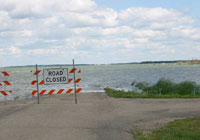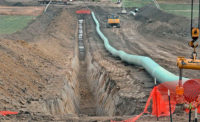The Corps of Engineers has formally recommended building a $186.7-million outlet for North Dakota's Devils Lake to combat flood damage and the threat that the land-locked lake will overflow. The Chief of Engineers, Lt. Gen. Robert B. Flowers, signed a record of decision for the outlet project on Oct. 14.
But the project still faces several hurdles, including questions about where the money will come from to fund the job.
 |
| Floods have caused more than $450 million in damages (Photo courtesy of North Dakota Water) |
The 129,000-acre lake in northeast North Dakota is saline and has no stream or river outlets. Over the past 10 years, water level at Devils Lake, the state's largest natural lake, has risen almost 24.5 feet, causing more than $450 million in damage in the area, according to the North Dakota State Water Commission.
The plan calls for building a 24-mile-long outlet with a capacity of 300 cubic ft per second to carry water from the lake to the Sheyenne River. It would have pumping facilities and a reservoir to regulate the flow as well as environmental mitigation features, the Corps says.
The project still requires Clean Water Act certification and a permit from North Dakota--and funding. The state has plans for a temporary outlet.
 |
| Sen. Dorgan worries about funding (Photo courtesy of the Office of Sen. Byron Dorgan) |
Sen. Byron Dorgan (D-N.D.) is "glad to have an official finding that something needed to be done to relieve pressure on the lake," says his communications director, Barry Piatt. But Piatt adds that Dorgan "thinks it took way too long to come to this conclusion and as a result the costs have gone up--to the point where you have to wonder whether this work's ever going to be done."
A preliminary environmental impact statement issued in February 2002 pegged the project's cost at $98 million. But since then, the estimate has nearly doubled. Randy Devendorf, a wildlife biologist in the Corps' St. Paul District, says factors behind the increase include a refinement of construction cost estimates plus some added features, including environmental mitigation, monitoring and a sand filter to reduce the transfer of biota from the lake to the river.
He says the outlet would begin at its north end as an open channel of about six miles. That would then be linked to two stretches, each more than eight miles long, of underground pipe. One segment would be ductile iron pipe; the other, reinforced concrete pipe.
|


Post a comment to this article
Report Abusive Comment